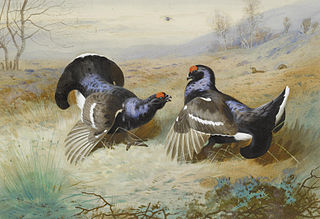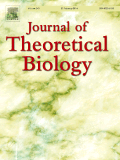Related Research Articles
An evolutionarily stable strategy (ESS) is a strategy that is impermeable when adopted by a population in adaptation to a specific environment, that is to say it cannot be displaced by an alternative strategy which may be novel or initially rare. Introduced by John Maynard Smith and George R. Price in 1972/3, it is an important concept in behavioural ecology, evolutionary psychology, mathematical game theory and economics, with applications in other fields such as anthropology, philosophy and political science.

Kin selection is a process whereby natural selection favours a trait due to its positive effects on the reproductive success of an organism's relatives, even when at a cost to the organism's own survival and reproduction. Kin selection can lead to the evolution of altruistic behaviour. It is related to inclusive fitness, which combines the number of offspring produced with the number an individual can ensure the production of by supporting others. A broader definition of kin selection includes selection acting on interactions between individuals who share a gene of interest even if the gene is not shared due to common ancestry.

William Donald Hamilton was a British evolutionary biologist, recognised as one of the most significant evolutionary theorists of the 20th century. Hamilton became known for his theoretical work expounding a rigorous genetic basis for the existence of altruism, an insight that was a key part of the development of the gene-centered view of evolution. He is considered one of the forerunners of sociobiology. Hamilton published important work on sex ratios and the evolution of sex. From 1984 to his death in 2000, he was a Royal Society Research Professor at Oxford University.
Fitness is a quantitative representation of individual reproductive success. It is also equal to the average contribution to the gene pool of the next generation, made by the same individuals of the specified genotype or phenotype. Fitness can be defined either with respect to a genotype or to a phenotype in a given environment or time. The fitness of a genotype is manifested through its phenotype, which is also affected by the developmental environment. The fitness of a given phenotype can also be different in different selective environments.

The handicap principle is a disputed hypothesis proposed by the Israeli biologist Amotz Zahavi in 1975. It is meant to explain how "signal selection" during mate choice may lead to "honest" or reliable signalling between male and female animals which have an obvious motivation to bluff or deceive each other. The handicap principle suggests that secondary sexual characteristics are costly signals which must be reliable, as they cost the signaller resources that individuals with less of a particular trait could not afford. The handicap principle further proposes that animals of greater biological fitness signal this through handicapping behaviour, or morphology that effectively lowers overall fitness. The central idea is that sexually selected traits function like conspicuous consumption, signalling the ability to afford to squander a resource. Receivers then know that the signal indicates quality, because inferior-quality signallers are unable to produce such wastefully extravagant signals.

Group selection is a proposed mechanism of evolution in which natural selection acts at the level of the group, instead of at the level of the individual or gene.

The Journal of Theoretical Biology is a biweekly peer-reviewed scientific journal covering theoretical biology, as well as mathematical, computational, and statistical aspects of biology. Some research areas covered by the journal include cell biology, evolutionary biology, population genetics, morphogenesis, and immunology.

George Robert Price was an American population geneticist. Price is often noted for his formulation of the Price equation in 1967.
In evolutionary biology, inclusive fitness is one of two metrics of evolutionary success as defined by W. D. Hamilton in 1964:
Evolutionary game theory (EGT) is the application of game theory to evolving populations in biology. It defines a framework of contests, strategies, and analytics into which Darwinian competition can be modelled. It originated in 1973 with John Maynard Smith and George R. Price's formalisation of contests, analysed as strategies, and the mathematical criteria that can be used to predict the results of competing strategies.
The gene-centered view of evolution, gene's eye view, gene selection theory, or selfish gene theory holds that adaptive evolution occurs through the differential survival of competing genes, increasing the allele frequency of those alleles whose phenotypic trait effects successfully promote their own propagation. The proponents of this viewpoint argue that, since heritable information is passed from generation to generation almost exclusively by DNA, natural selection and evolution are best considered from the perspective of genes.

In biology, altruism refers to behaviour by an individual that increases the fitness of another individual while decreasing their own. Altruism in this sense is different from the philosophical concept of altruism, in which an action would only be called "altruistic" if it was done with the conscious intention of helping another. In the behavioural sense, there is no such requirement. As such, it is not evaluated in moral terms—it is the consequences of an action for reproductive fitness that determine whether the action is considered altruistic, not the intentions, if any, with which the action is performed.
In evolution, cooperation is the process where groups of organisms work or act together for common or mutual benefits. It is commonly defined as any adaptation that has evolved, at least in part, to increase the reproductive success of the actor's social partners. For example, territorial choruses by male lions discourage intruders and are likely to benefit all contributors.
Kin recognition, also called kin detection, is an organism's ability to distinguish between close genetic kin and non-kin. In evolutionary biology and psychology, such an ability is presumed to have evolved for inbreeding avoidance, though animals do not typically avoid inbreeding.

Group Selection is a 1971 book edited by George C. Williams, containing papers written by biologists arguing against the view of group selection as a major force in evolution. The group of biologists writing on a single unified theme contrasts with Williams' earlier seminal 1966 book Adaptation and Natural Selection, whose arguments Williams suspected to be his alone. In particular it contains a reprint, with an erratum, of W.D. Hamilton's classic 1964 paper on inclusive fitness, "The Genetical Evolution of Social Behavior" plus a paper by John Maynard Smith entitled "The Origin and Maintenance of Sex", containing ideas on evolution of sex later developed by Maynard Smith; see especially his 1978 book The Evolution of Sex.

Eusociality evolved repeatedly in different orders of animals, notably termites and the Hymenoptera. This 'true sociality' in animals, in which sterile individuals work to further the reproductive success of others, is found in termites, ambrosia beetles, gall-dwelling aphids, thrips, marine sponge-dwelling shrimp, naked mole-rats, and many genera in the insect order Hymenoptera. The fact that eusociality has evolved so often in the Hymenoptera, but remains rare throughout the rest of the animal kingdom, has made its evolution a topic of debate among evolutionary biologists. Eusocial organisms at first appear to behave in stark contrast with simple interpretations of Darwinian evolution: passing on one's genes to the next generation, or fitness, is a central idea in evolutionary biology.
Microorganisms engage in a wide variety of social interactions, including cooperation. A cooperative behavior is one that benefits an individual other than the one performing the behavior. This article outlines the various forms of cooperative interactions seen in microbial systems, as well as the benefits that might have driven the evolution of these complex behaviors.
Darwinian anthropology describes an approach to anthropological analysis which employs various theories from Darwinian evolutionary biology. Whilst there are a number of areas of research that can come under this broad description some specific research projects have been closely associated with the label. A prominent example is the project that developed in the mid 1970s with the goal of applying sociobiological perspectives to explain patterns of human social relationships, particularly kinship patterns across human cultures.
Inclusive fitness in humans is the application of inclusive fitness theory to human social behaviour, relationships and cooperation.
Reciprocal altruism in humans refers to an individual behavior that gives benefit conditionally upon receiving a returned benefit, which draws on the economic concept – ″gains in trade″. Human reciprocal altruism would include the following behaviors : helping patients, the wounded, and the others when they are in crisis; sharing food, implement, knowledge.
References
- ↑ Hamilton W.D. (July 1964). "The genetical evolution of social behaviour. I". J. Theor. Biol. 7 (1): 1–16. doi:10.1016/0022-5193(64)90038-4. PMID 5875341.
- ↑ Hamilton W.D. (July 1964). "The genetical evolution of social behaviour. II". J. Theor. Biol. 7 (1): 17–52. doi:10.1016/0022-5193(64)90039-6. PMID 5875340.
- ↑ Smith, J. M. (1964). "Group Selection and Kin Selection". Nature. 201 (4924): 1145–7. doi:10.1038/2011145a0. S2CID 4177102.
- ↑ Hamilton, W. D. (1963). "The evolution of altruistic behaviour". American Naturalist. 97 (896): 354–6. doi:10.1086/497114. S2CID 84216415.
- ↑ Williams, G.C. ed (1971) Group Selection
- ↑ Hamilton, W. D. (1996). Narrow roads of gene land: The collected papers of W. D. Hamilton. Vol. 1. Oxford, [England]: W.H. Freeman/Spektrum. ISBN 0-7167-4530-5.
- ↑ Hamilton, W.D. (1988) This week's Citation Classic: The Genetical Evolution of Social Behaviour